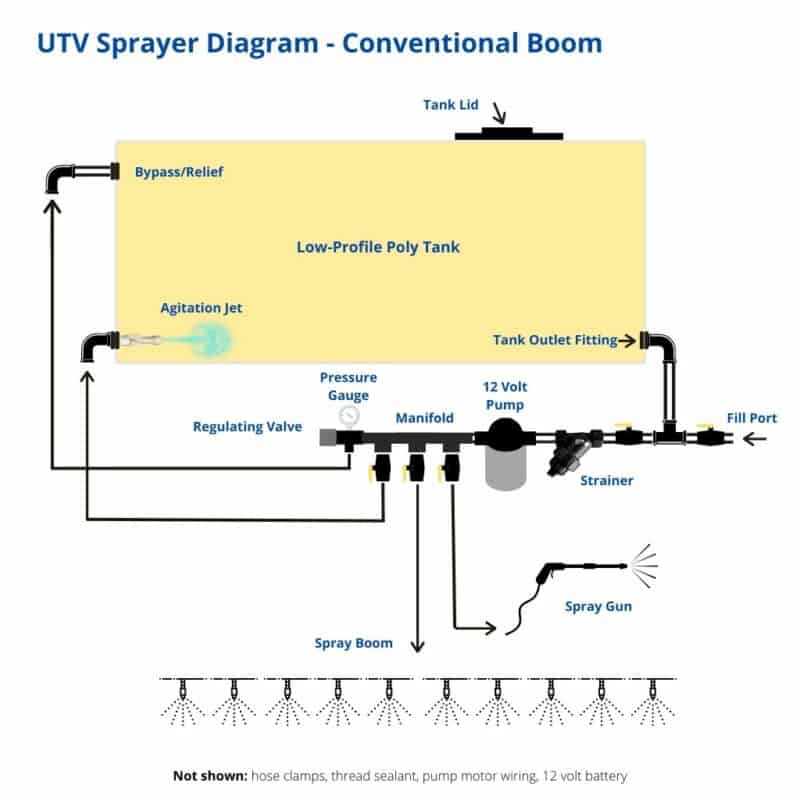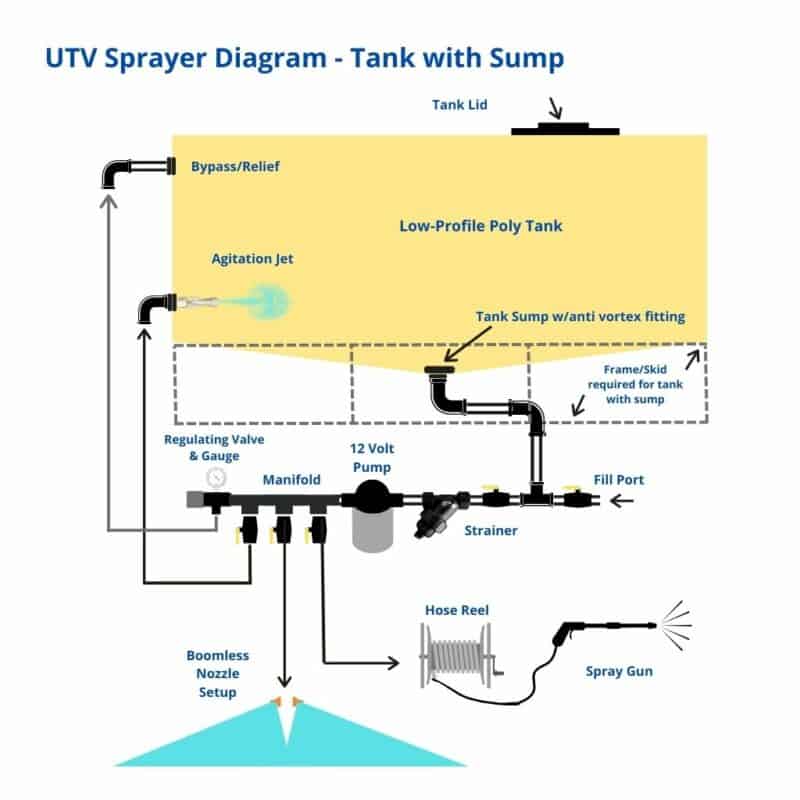With the increased prominence of UTVs in the agriculture and industrial world, UTV sprayers have also grown in popularity. It makes perfect sense, if you have a UTV you can easily make it into an even more valuable tool with a simple sprayer that can cover a lot of ground and many different types of terrain.
Many of the UTV sprayers available on the market may seem complicated but you can build one pretty easily with some basic components. This article is going to provide the basic plumbing layout for both a conventional boom and a boomless UTV sprayer.
UTV Sprayer Parts List
- Tank
- Pump
- Regulating Valve
- Manifold
- Ball valves
- Strainer
- Suction hose
- Discharge hose
- Spray boom
- Conventional
- Boomless
- Sprayer nozzles
- Flat fan
- Boomless
RELATED: How to Build a Lawn Sprayer That Lasts
UTV Sprayer Types
There are many different ways to build a UTV sprayer. The boom type, pump type, and tank size are a few of the main components and there are several options for each of these. How do you decide which is best for you? It depends on several things but these are the main aspects to consider:
- Where will you spray? A conventional boom will provide the most even and effective coverage, but it is wide and harder to operate on rough ground with trees or other obstacles. A boomless sprayer won’t provide the same even coverage but maneuver terrain with lots of obstacles.
- What will you spray? Turf, row crops, sidewalks, ditches, etc. If you are spot spraying areas in a pasture you may not need a boom, but if you want to spray your entire pasture you definitely will.
- How much volume will you spray? A 12-volt pump will work great for small volumes, but if you are spraying more than 10 gallons per acre or using the sprayer for de-icing, then you will likely need a bigger pump.
- How much weight can your UTV handle? A fully loaded 100-gallon sprayer might weigh close to 1000 pounds. Be sure your UTV can handle the weight of a loaded sprayer.
UTV Sprayer Pump Options
- 12-Volt Pump: 12-volt sprayer pumps are relatively inexpensive. They produce good pressure for small sprayer booms and spray wands. They are easily powered by the UTV battery and they are also easy to use. They are limited to about 5 gallons per minute and 40-60 psi.
- Centrifugal Pump: A centrifugal pump is more expensive than a 12-volt sprayer pump, but it can produce a lot more volume. They do require more horsepower, so when used on a UTV sprayer you would generally need a gas-engine-driven centrifugal pump.
- Diaphragm Pump: A diaphragm pump can produce a lot more pressure than the other types. This is necessary if you want to achieve great spray distances of 30 or more feet. If you spray trees or road ditches, or hard-to-reach areas, a gas-engine diaphragm pump would be required.
UTV Sprayer Tank Options
- Low-profile: There are many different tank shapes and styles. For a UTV it is best to use a tank that is short and wide. This keeps the center of gravity lower which Is important for rougher terrain, hills, ditches, roadsides, etc.
- Sump: Many tanks have an outlet on the bottom of one side wall. This works fine, but to completely drain the sprayer tank you want a tank that slopes to a sump in the bottom. This ensures that the pump is not starved of liquid when the level gets low or you are spraying on a slight incline.
- 50-100 gallons: Tanks obviously come in many different sizes. For a UTV a 50-gallon sprayer will probably be as much as it can handle. A 50-gallon sprayer will generally be enough to cover 5 to 10 acres of land on one tankful. This will vary based on your application rate.
UTV Boom Types
- Conventional Boom: A conventional sprayer boom is what you probably think of when you think of a sprayer. It is a bar that sticks out wider than the sprayer or UTV itself and has a series of flat fan nozzles or sprayer “tips” that are evenly spaced across the bar. The fan pattern of each tip overlaps with the one next to it to ensure that all the surface is covered. A conventional boom will provide a fine mist and the most thorough coverage on the ground or the surface of the plant you spray.
- Boomless: A “boomless” sprayer setup is actually just a pair of nozzles that will spray in a much wider pattern than a conventional boom nozzle. They can cover a similar spray width with only these two nozzles. The advantage is that these are less costly and easier to maneuver. For a more thorough explanation refer to this post where I lay out in detail the specific differences between a boom and boomless sprayer.
Conventional UTV Sprayer Diagram

Boomless UTV Sprayer Diagram

RELATED: How to Build a DIY Spray Boom
UTV Sprayer with Sump

A low-profile tank has a shorter sidewall, therefore a fitting in the side that serves as your withdrawal might make it hard to get all the liquid out of the tank. A tank with a bottom that slopes to a center sump is a better design, that will allow for easy and complete draining of the tank. This kind of tank does need to be held on a skid to accommodate the outlet on the bottom of the tank and the necessary plumbing to feed the pump.
Key Features to Include on Your UTV Sprayer
- Anti-vortex fitting: An anti-vortex fitting is located on the tank outlet fitting and prevents a vortex from being created as the pump sucks liquid out of the tank. This is especially necessary for a centrifugal pump because they generate a lot of suction and if they pull in too much air it can damage the pump.
- Hose reel: If you are going to spray by hand with a spray gun, you will want a long enough length of hose to reach areas where you cannot drive up close. Wrangling all that hose is difficult without a hose reel. Even as little as 25 or 30 ft of hose can be a pain to handle.
- Recirculation/agitation: A regulating valve will bypass liquid to the tank and provide some agitation, but to keep your spray solution thoroughly mixed you should install an agitation nozzle in the tank and dedicate a line separate from the by-pass line. You can learn more about installing agitation in this article.
- Nozzle body check valves: After you shut off your sprayer, the nozzles will continue to drip until all the liquid is out of the boom hoses and plumbing from the tank. This can be stopped by using nozzle bodies on your spray boom that have built-in check valves. These valves close when the system pressure drops below a certain level. If you are uncertain what a nozzle body is, then be sure to read this article that provides descriptions of basic sprayer components.
- Electronic sprayer control: Although manual controls work just fine, Electric valves allow you to control your sprayer from your seat as you spray. Not only can a simple 12 V ball valve be used to turn on and off your spray boom, but you can also use an electronic regulating valve to control the output of your sprayer as well as shut off your pump remotely. For a detailed breakdown of the different types of sprayer controls available read my post on electronic sprayer controls where I break down the different types and what is required for each setup.
A UTV is a versatile tool with the right components you can turn into a very useful and inexpensive sprayer

